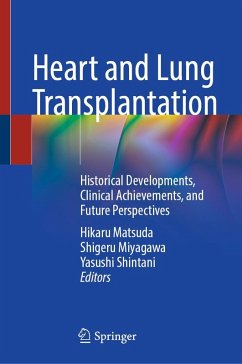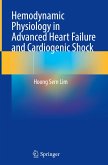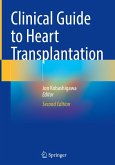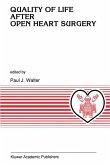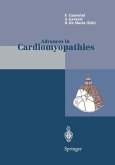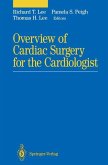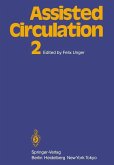Heart and Lung Transplantation
Historical Developments, Clinical Achievements, and Future Perspectives
Herausgegeben:Matsuda, Hikaru; Miyagawa, Shigeru; Shintani, Yasushi
Heart and Lung Transplantation
Historical Developments, Clinical Achievements, and Future Perspectives
Herausgegeben:Matsuda, Hikaru; Miyagawa, Shigeru; Shintani, Yasushi
- Gebundenes Buch
- Merkliste
- Auf die Merkliste
- Bewerten Bewerten
- Teilen
- Produkt teilen
- Produkterinnerung
- Produkterinnerung
This edited volume explores current research and future developments in transplantation medicine. Key sections include advances in organ preservation, mechanical circulatory support, and emerging fields such as organ transplantation from cardiac death donors (DCD), pediatric application of ventricular assist device (VAD), immunological tolerance and xenotransplantation. With contributions from leading U.S. experts in pediatric VAD therapy, DCD heart and lung transplantations, combined heart and kidney transplantation, the book provides a forward-looking perspective on how these innovations…mehr
Andere Kunden interessierten sich auch für
![Surgical Treatment for Advanced Heart Failure Surgical Treatment for Advanced Heart Failure]() Surgical Treatment for Advanced Heart Failure113,99 €
Surgical Treatment for Advanced Heart Failure113,99 €![Hemodynamic Physiology in Advanced Heart Failure and Cardiogenic Shock Hemodynamic Physiology in Advanced Heart Failure and Cardiogenic Shock]() Hoong Sern LimHemodynamic Physiology in Advanced Heart Failure and Cardiogenic Shock105,99 €
Hoong Sern LimHemodynamic Physiology in Advanced Heart Failure and Cardiogenic Shock105,99 €![Clinical Guide to Heart Transplantation Clinical Guide to Heart Transplantation]() Clinical Guide to Heart Transplantation75,99 €
Clinical Guide to Heart Transplantation75,99 €![Quality of Life after Open Heart Surgery Quality of Life after Open Heart Surgery]() Quality of Life after Open Heart Surgery39,99 €
Quality of Life after Open Heart Surgery39,99 €![Advances in Cardiomyopathies Advances in Cardiomyopathies]() Advances in Cardiomyopathies39,99 €
Advances in Cardiomyopathies39,99 €![Overview of Cardiac Surgery for the Cardiologist Overview of Cardiac Surgery for the Cardiologist]() Overview of Cardiac Surgery for the Cardiologist83,99 €
Overview of Cardiac Surgery for the Cardiologist83,99 €![Assisted Circulation 2 Assisted Circulation 2]() Assisted Circulation 277,99 €
Assisted Circulation 277,99 €-
-
-
This edited volume explores current research and future developments in transplantation medicine. Key sections include advances in organ preservation, mechanical circulatory support, and emerging fields such as organ transplantation from cardiac death donors (DCD), pediatric application of ventricular assist device (VAD), immunological tolerance and xenotransplantation. With contributions from leading U.S. experts in pediatric VAD therapy, DCD heart and lung transplantations, combined heart and kidney transplantation, the book provides a forward-looking perspective on how these innovations will transform the field. The book also details the historical journey of organ transplantation in Japan, from its early challenges to the significant revival of heart transplantation in 1999. It presents the impressive clinical results achieved at the First Department of Surgery at Osaka University Medical School.
Heart and lung transplantation: Historical Developments, Clinical Achievements, and Future Perspectives is essential reading for medical professionals, researchers, and students interested in the latest advances and future directions in organ transplantation.
Heart and lung transplantation: Historical Developments, Clinical Achievements, and Future Perspectives is essential reading for medical professionals, researchers, and students interested in the latest advances and future directions in organ transplantation.
Produktdetails
- Produktdetails
- Verlag: Springer / Springer Nature Singapore / Springer, Berlin
- Artikelnr. des Verlages: 978-981-96-8809-8
- Seitenzahl: 320
- Erscheinungstermin: 19. Juli 2025
- Englisch
- Abmessung: 241mm x 160mm x 22mm
- Gewicht: 703g
- ISBN-13: 9789819688098
- ISBN-10: 9819688094
- Artikelnr.: 74304204
- Herstellerkennzeichnung
- Springer-Verlag KG
- Sachsenplatz 4-6
- 1201 Wien, AT
- ProductSafety@springernature.com
- Verlag: Springer / Springer Nature Singapore / Springer, Berlin
- Artikelnr. des Verlages: 978-981-96-8809-8
- Seitenzahl: 320
- Erscheinungstermin: 19. Juli 2025
- Englisch
- Abmessung: 241mm x 160mm x 22mm
- Gewicht: 703g
- ISBN-13: 9789819688098
- ISBN-10: 9819688094
- Artikelnr.: 74304204
- Herstellerkennzeichnung
- Springer-Verlag KG
- Sachsenplatz 4-6
- 1201 Wien, AT
- ProductSafety@springernature.com
H. Matsuda served as the Professor and Chairman of the First Surgery Department of Osaka University School of Medicine from 1991 to 2005 succeeding Professor Yasunaru Kawashima (giving a Foreword to this book), and was a leading figure in cardiac surgery and opinion leader in organ transplantation in Japan. He started his career from pediatric cardiac surgery for complex heart disease, with research for myocardial protection, mechanical circulatory support, his team performed the first case of heart and lung transplantations from brain death donors in 1999 and 2000, contributing to the following smooth introduction of the organ transplantation from brain-dead donor in Japan. After retirement he has kept working to popularize organ transplantation, making a significant contribution to the current establishment of organ transplantation and mechanical circulatory support in Japan. The team has been keeping the leading position in these fields, with current Professor Yasushi Shintani of General Thoracic Surgery and Professor Shigeru Miyagawa of Cardiovascular Surgery, both are contributing as co-editors. Dr. S. Miyagawa graduated from Osaka University Medical School in 1994 and started his career as a cardiac surgeon at the First Department of Surgery (Professor H. Matsuda).¿After completing his residency program, he joined the research group of Dr. Y. Sawa (Professor from 2006 to 2020) in the field of regenerative medicine for heart failure and obtained his Ph.D. degree. In 2006, he moved to Germany and joined the research group at the Max Plank Institute and also worked as a visiting surgeon at the Kenhoff Hospital in Bad Nauheim until 2009. He returned to Osaka University and started the iPS research focusing on cell sheet therapy for advanced heart failure, establishing the clinical trial in 2020. In 2021, he was appointed as Professor and Chairman of the Department of Cardiovascular Surgery of Osaka University Graduate School of Medicine, and now he is the key leader in heart transplantation in Japan and also in regenerative therapy for heart failure as well known internationally. Currently, he is working on destination therapy by durable ventricular assist device and also to start heart transplantation from donor of circulatory death. Dr. Yasushi Shintani graduated from Osaka University in 1995 and began his career in general thoracic surgery at the former First Department of Surgery. In 2004, he earned his Ph.D. for research on the mechanisms of lung cancer metastasis. He then spent over three years conducting research at the Eppley Cancer Center, University of Nebraska Medical Center (NE, USA), where he focused on the tumor microenvironment. After over 10 years period working as a main faculty member of General Thoracic Surgery at Osaka University, Dr. Shintani was appointed to the Professor and Chief in April 2019. Until now, he performs surgical procedures for a wide range of respiratory diseases, including lung cancer, emphysematous pulmonary diseases, myasthenia gravis, mediastinal tumors, pneumothorax, and empyema. His department serves as a designated center for pulmonary transplantation. In the field of lung transplantation, he has led numerous pioneering efforts in Japan, including the first brain-dead lung transplant. His team has performed 83 brain-dead lung transplants, 11 living-donor lobar lung transplants, and 3 combined heart-lung transplants. Recently, his research has expanded to include organ preservation using ex vivo lung perfusion, elucidation of chronic lung allograft dysfunction (CLAD) mechanisms, and donation after circulatory death (DCD) lung transplantation.
Part 1 Historical Review.- Chapter 1 Heart and lung transplantation in Japan: How prepared and what to do now.- Part 2 Organ Preservation.- Chapter 2 Heart preservation: Myocardial protection, Cardioplegic arrest, Controlled reperfusion, and Transplantation.- Chapter 3 Lung Preservation: Cold static preservation solutions for lung transplantation.- Part 3 Mechanical Circulatory Support.- Chapter 4 Mechanical circulatory support in advanced heart failure: Acute support, Ventricular assist device, Bridge to transplantation, and Bridge to recovery.- Chapter 5 Role of implantable ventricular assist device in end-stage heart failure: bridge to transplantation and destination therapy.- Chapter 6 Destination therapy: Background and future prospects.- Part 4 Clinical achievements in heart and lung transplantation.- Chapter 7 Pioneering Heart Transplantation in Japan: A 25-Year Journey at Osaka University.- Chapter 8 Lung Transplantation at Osaka University.- Chapter 9: Combined heart and lung transplantation: Report of three cases.- Chapter 10 Heart Transplantation in National Cerebral and Cardiovascular Center.- Chapter 11 Surgical Considerations in Heart Transplantation: Technical view point.- Part V Medical management of heart failure update.- Chapter 12 Therapeutic Strategies for Advanced Heart Failure Related to Heart Transplantation.- Chapter 13 Medical and Surgical Management of Adult Congenital Heart Disease.- Chapter 14 Social Reintegration in Survivors of Pediatric Heart Transplantation.- Part 6 Future Perspectives.- Chapter 15 Pediatric Heart Failure Management with Ventricular Assist Device and Heart Transplantation.- Chapter 16: Ventricular Assist Device for Children: State of the Art and Future Directions.- Chapter 17 Lung Donation after Circulatory Death: Current Challenges and Opportunities in United States.- Chapter 18 Advancing Donor Lung Preservation and Repair: The Role of Machine Perfusion in Modern Lung Transplantation.- Chapter 19 Marginal donors in heart transplantation: Development of a risk score formula for primary graft failure.- Chapter 20 Exploring advancements in DCD heart transplantation: Preservation techniques, ethical challenges, and clinical Outcomes.- Chapter 21 Multi-Organ Transplantation in the United States.- Chapter 22 Transplantation Immunology in Lung.- Chapter 23 Immunological Transplantation Tolerance-Availability of rat transplant models for clinical application.- Chapter 24 Aiming for the clinical application of xenotransplantation.
Part 1 Historical Review.- Chapter 1 Heart and lung transplantation in Japan: How prepared and what to do now.- Part 2 Organ Preservation.- Chapter 2 Heart preservation: Myocardial protection, Cardioplegic arrest, Controlled reperfusion, and Transplantation.- Chapter 3 Lung Preservation: Cold static preservation solutions for lung transplantation.- Part 3 Mechanical Circulatory Support.- Chapter 4 Mechanical circulatory support in advanced heart failure: Acute support, Ventricular assist device, Bridge to transplantation, and Bridge to recovery.- Chapter 5 Role of implantable ventricular assist device in end-stage heart failure: bridge to transplantation and destination therapy.- Chapter 6 Destination therapy: Background and future prospects.- Part 4 Clinical achievements in heart and lung transplantation.- Chapter 7 Pioneering Heart Transplantation in Japan: A 25-Year Journey at Osaka University.- Chapter 8 Lung Transplantation at Osaka University.- Chapter 9: Combined heart and lung transplantation: Report of three cases.- Chapter 10 Heart Transplantation in National Cerebral and Cardiovascular Center.- Chapter 11 Surgical Considerations in Heart Transplantation: Technical view point.- Part V Medical management of heart failure update.- Chapter 12 Therapeutic Strategies for Advanced Heart Failure Related to Heart Transplantation.- Chapter 13 Medical and Surgical Management of Adult Congenital Heart Disease.- Chapter 14 Social Reintegration in Survivors of Pediatric Heart Transplantation.- Part 6 Future Perspectives.- Chapter 15 Pediatric Heart Failure Management with Ventricular Assist Device and Heart Transplantation.- Chapter 16: Ventricular Assist Device for Children: State of the Art and Future Directions.- Chapter 17 Lung Donation after Circulatory Death: Current Challenges and Opportunities in United States.- Chapter 18 Advancing Donor Lung Preservation and Repair: The Role of Machine Perfusion in Modern Lung Transplantation.- Chapter 19 Marginal donors in heart transplantation: Development of a risk score formula for primary graft failure.- Chapter 20 Exploring advancements in DCD heart transplantation: Preservation techniques, ethical challenges, and clinical Outcomes.- Chapter 21 Multi-Organ Transplantation in the United States.- Chapter 22 Transplantation Immunology in Lung.- Chapter 23 Immunological Transplantation Tolerance-Availability of rat transplant models for clinical application.- Chapter 24 Aiming for the clinical application of xenotransplantation.

